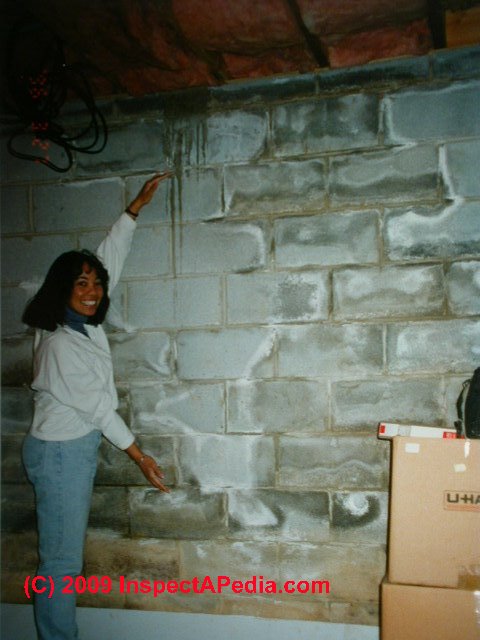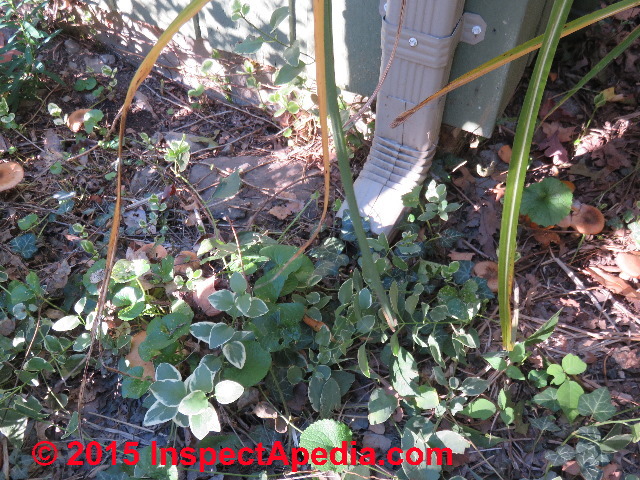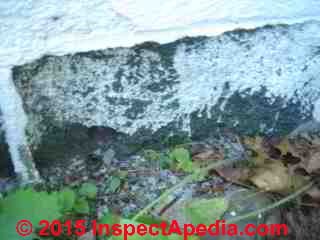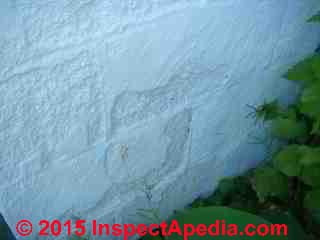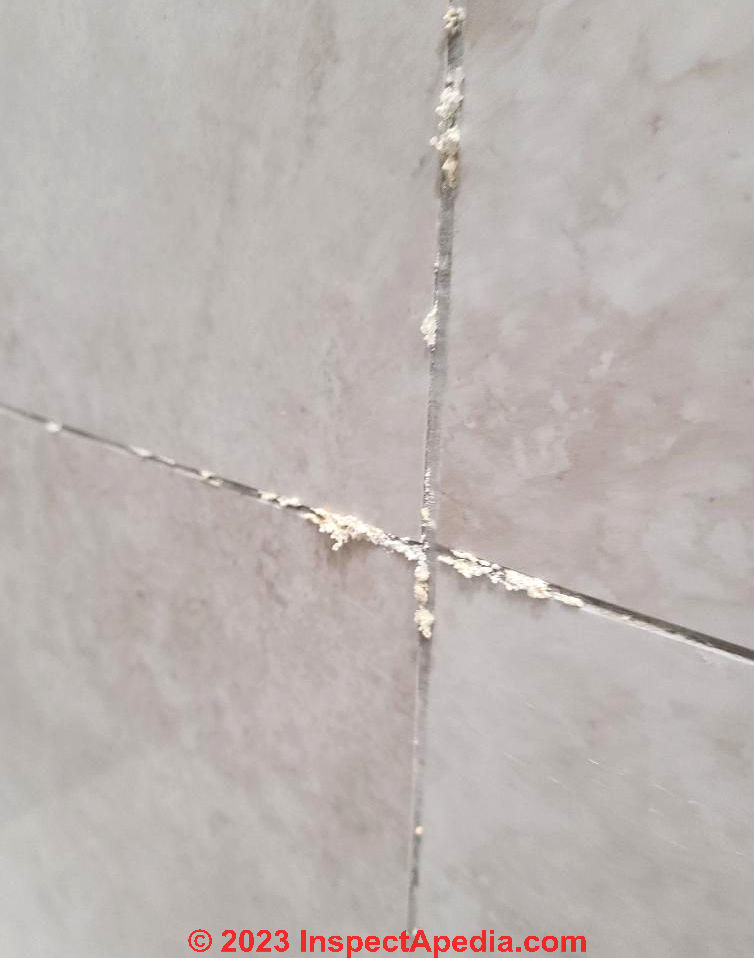 Mineral Efflorescence: Building Damage Indicators
Mineral Efflorescence: Building Damage Indicators
How efflorescence indicates building moisture problems
- POST a QUESTION or COMMENT about how efflorescence indicates moisture concerns for a building
Efflorescence salts or stains on building surfaces such as foundations, walls, walks, drives, and clay, concrete, or slate roofs form a fuzzy or crystalline deposit that indicates moisture or dampness problems.
What does efflorescence mean as an indicator of moisture problems in buildings? What does that moisture risk indicate for building damage or concerns?
Our photo at page top shows white fluffy crystals of mineral efflorescence near the bottom of a poured concrete foundation wall.
Note: for those of us who are not great spellers, this word is often misspelled as effloresence or as effloresents or other versions. In most of our text we'll use the proper spelling.
InspectAPedia tolerates no conflicts of interest. We have no relationship with advertisers, products, or services discussed at this website.
- Daniel Friedman, Publisher/Editor/Author - See WHO ARE WE?
Recognize the Concerns Indicated by the Presence of Efflorescence
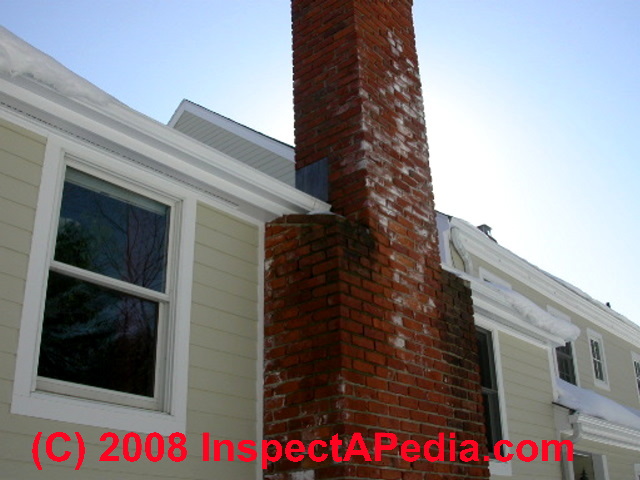 It is important to recognize efflorescence as an indicator of the moisture or water flooding or leak history of a building because those conditions in turn can cause costly damage, mold contamination, or other unhappy conditions.
It is important to recognize efflorescence as an indicator of the moisture or water flooding or leak history of a building because those conditions in turn can cause costly damage, mold contamination, or other unhappy conditions.
Our photo above shows white efflorescence on the outside of a masonry chimney - discussed separately
How to identify signs of moisture or water entry in buildings & signs of high moisture.
Although efflorescence and mineral salts left behind by water are not mold, they mean that mold-friendly conditions are present in the building.
See
EFFLORESCENCE SALTS & WHITE DEPOSITS
to learn how to identify efflorescence as well as its possible age.
Article Contents
- EFFLORESCENCE INDOORS MEANS WET OR HUMID BASEMENTS OR CRAWL SPACES
- EFFLORESCENCE INDOORS RISKS MOLD, ROT, INSECT DAMAGE FROM BUILDING MOISTURE
- EFFLORESCENCE INDICATOR OF DAMAGE TO OLDER BUILDING FOUNDATION MATERIALS
What Does it Mean to Find Efflorescence and Stains in a Building Interior?
Risks include: moisture, leaks, mold, rot, bug damage
Interior or exterior efflorescence found on building surfaces (virtually always masonry or some kind of painted or coated masonry) means that there are wet conditions at the property.
In turn, these wet conditions can be the cause of other building problems such as rot, insect attack, or mold contamination.
Efflorescence Indoors Means Wet or Humid Basements or Crawl Spaces
In our photograph at above left the client is pointing out that water has been entering this basement from the very top of the foundation wall (due to outside roof spillage and bad drainage).
We did not agree with the contractor who told her this was "rising damp" due to wet soils. Rising damp would hardly leap from floor to foundation wall top in a specific narrow area such as this one. Rising damp can't jump.
At above right, in a Poughkeepsie NY home, we see the classic downspout spilling by the corner of the foundation problem indicated by dark water stains and white efflorescence in an inverted "Vee" at the basement foundation wall corner.
Outside, large buried rock may play a role in directing surface runoff towards the foundation, but it makes sense to correct the inexpensive obvious mistakes first.
Efflorescence Indoors Risks Mold, Rot, Insect Damage from Building Moisture
Below you see one of the downspout ends at the same home - spilling right by the foundation wall in an area that does not drain away from the structure.
Watch out: MOLD & HEALTH WARNING: although efflorescence is not mold, it often indicates wet conditions that cause problem mold growth elsewhere in the same building.
Moisture from a damp or wet basement or crawl area will pass upwards through the building riding on rising air through air bypass leaks or even moving simply because of vapor pressure differences: moisture always moves from a more damp area towards a more dry area.
Higher in the building, even in the building top floors, attic or cathedral ceilings, this same moisture may become trapped in or condense in building cavities leading to a costly hidden mold problem.
Attic condensation of building moisture is illustrated
and at ATTIC MOLD CAUSES.
In sum, the downspout spillage shown at above right might be causing basement or crawl space water entry (shown above) that in turn might be the source of the moisture found in an attic and dancing there in the form of frost or mold or roof sheathing stains (photo at above right).
You'll need to identify the sources of moisture or leaks and correct them, and depending on other building air quality complaints or health concerns it may be appropriate to inspect and screen the building for problem mold or other moisture or water-related problems.
Where you find efflorescence in a building indoors, you should look for problem mold, allergens, bacteria. Look on organic surfaces - wood, paper, painted surfaces, insulation, fabrics, carpets, carpet padding, or in settled dust and debris. Keep in mind that mold may also be hidden in building insulation that has been wet even it it looks clean.
Efflorescence Might Explain Damage to Older Building Foundation Materials
Efflorescence and water stains may explain spalling brick or concrete block foundation walls observed in a basement or crawl space. Putting aside for a moment all the whining I've already done above about mold, rot, bugs, and wet-basement anxiety, efflorescence on a masonry foundation more likely to be a cosmetic issue or a moisture diagnostic clue than a structural problem.
Watch out: but the same water around a foundation or under a concrete slab that is causing efflorescence and water stains might also be a source of foundation or slab damage from frost, earth pressure, or in some locales, expansive clay soils. A careful inspection of the building foundation can help put this question out to pasture.
Reader Question: Has the foundation of my building been damaged by efflorescence?
I am sure from your wonderful informative site and comments that the home I'm looking to put a bid on has this Mineral Efflorescence problem. My question is: the home was build in 1950, and I guess may have sand block for basement foundation.
With the walls having been wet and causing the problem could the strength of the foundation be effected? I will fix the leakage if/when I get it,but if the foundation is soft couldn't the home be jeopardized in crumbling apart?
Also, the is only walk-in height to the older part of the home and it appears the additions put on in 1992 can't be inspected correctly due to being crawl spaces. I would imagine there may not be that issue in there as it's newer block but again I understand that water is water if leak is extensive and may be mineral effected too.
They do have a dehumidifier down there and it does not smell musty or damp. Thanks in advance for help on this. - 2015/10/27 Nancy Sustersic
Reply:
I'm not sure what "sand block" is - I use the terms "concrete block", "cinder block" - an older softer form of concrete block, and masons call these building units "masonry block". I infer that the masonry block in your building is relatively soft or perhaps crumbly.
I can't accurately diagnose just what's going on from just an e-text and I'd like to see some photos of the condition of the foundation as well as photos of the home exterior to get an idea what's happening with roof or surface drainage around the home. Our email is at the page bottom CONTACT link.
If there is superficial spalling of the block - less than 3/4" deep into the block surface, and if there is no bulging, cracking, settlement, movement, crushing, then most likely we're talking about a water entry and moisture issue and a cosmetic issue. Below the spalling concrete block foundation wall damage is in my opinion superficial and cosmetic, not structural, but it does tell us
- that there has been water or roof spillage by the foundation wall
- there may be water entry inside the basement or crawl area of the building
- that someone knew of this condition as the foundation in one of the photos was painted with a masonry sealer.
The photos of spalling concrete block foundation walls shown above were contributed by Kingston NY home inspector Arlene Puentes. See ABOUT InspectApedia.com for her contact information.
Most masonry foundations have far more compression strength than needed to support the weight of a typical 1-3 floor residential structure. But if you see actual compression or other actual foundation damage such as I listed above, I'd ask for a repair estimate from an experienced mason.
Limited inspection of crawl spaces is indeed a concern and a topic of debate among home inspectors; while I don't want anyone to go into an unsafe space, I find that the worst problems often are lurking in areas that are hard, scary, or even impossible to access. In that case I
- look at other clues that suggest hidden trouble such as building movement, cracks, evidence of repeated repair
- look for the history of water entry that suggests rot, mold, insect problems under the floors
- decide when the external visual clues + risk mean it's cost-justified to make an invasive opening to inspect where otherwise we cannot see.
See SPALLING CONCRETE BLOCK WALLS & CHIMNEYS for help identifying block foundation damage and for more about spalling concrete block.
See "Dan's 3 D's" in my article
titled FEAR-O-METER: Dan's 3 D's SET REPAIR PRIORITIES
to read more about how to decide when to dig deeper.
Efflorescence on the Building Exterior
Please see EFFLORESCENCE REMOVAL & PREVENTION for examples of white mineral efflorescence deposits on a building exterior on chimneys or foundation and a discussion of the cause and cure for that condition.
...
Reader Comments, Questions & Answers About The Article Above
Below you will find questions and answers previously posted on this page at its page bottom reader comment box.
Reader Q&A - also see RECOMMENDED ARTICLES & FAQs
On 2022-04-12 by Tara
The HVAC return from my neighbors apartment leaked all over the concrete and flooded outside of our apartments last summer. There has since been all sorts of mineral stains to the concrete. Is this a potential health hazard?
On 2022-04-12 by Inspectapedia Com Moderator - HVAC return leaked all over the concrete
@Tara,
We'll be glad to help, but first need to understand your question more clearly.
An HVAC "return" is an air duct bringing building air from the occupied space back to the air handler for heating or cooling.
Such an air duct would not plausibly leak water sufficient to "flood all over" any building interior and absolutely not its exterior.
So I will make a wild guess that you meant that a condensate handling system leaked or wet some sort of concrete surface, perhaps a sidewalk or patio, outside.
It is improper and in many areas a building code violation to discharge A/C condensate onto a walkway - because of the risk of forming algae or creating a slip/fall hazard.
Indoors there is a concern for proper condensate handling because of bacteria or even water-molds that might be present in such discharge (e.g. legionnaire's disease).
But "mineral stains" in your note could simply be salts like those discussed on this page.
On 2022-01-19 by Dave L.
Just had my Florida second home bathroom totally renovated, it was finished in April 2021, when I went there in October I had what my contractor call mold, reading these posts, I am more thinking its efflorescence.
After cleaning it away, I came back in December and found that same location looking wet, I purchased a moisture meter and it says it wet, but only in the single intersection. Any Ideas? No showers have been taken between April and October or October to December.
On 2022-01-19 by Inspectapedia Com Moderator - efflorescence indicates leak & hidden damage risk behind new tile job
@Dave L.,
I agree with your assessment: that looks like efflorescence, not mold.
Once water leaks behind a tiled wall it can take a very long time to dry out; the deposits you see are typically left behind by evaporating moisture.
The troubling news is that if that tile is on drywall there's a risk of a mold reservoir in the wall cavity - water+ drywall -> mold.
The better news is it probably doesn't need to be treated as an emergency.
Given that the wall is tiled and I'd hate to have to tear it off I might see if I could cut an inspection opening through drywall on the opposite side of this wall if that's accessible.
But, arguing with myself, the tile job seems to be questionable: if water leaks into the wall from a brand new tile job in a bath renovation I suspect proper materials and methods were not used. So it's going to leak again and again. Just re-grouting the tile joints may slow the leaks but it won't make a waterproof wall.
Was the tile installed on cement board or on drywall? On cement board I'd be a little less concerned.
On 2020-02-28 by MortQuaid - efflorescence on stone and stucco facade
We have noticed efflorescence develop on the stone on our stone and stucco facade several years after construction. Directly behind this area, on the interior drywall, mold has developed behind one of our picture frames.
This is the only area of the house where mold has developed behind a picture frame hanging on an exterior wall. Is this likely a sign of excessive moisture behind the drywall, and is it worth cutting a hole in the sheetrock for further inspection?
Thanks!
Mort
On 2020-02-29 - by (mod) - How to investigate efflorescence developing on a stone and stucco facade
Thanks for an interesting Question, Mort.
I have to argue with myself on this one.
It's odd to have a leak high in the middle of a wall with no further evidence below that point, and on occasion in a damp interior I've found mold behind the picture from simple condensation on the exposed wall surface. If I thought that were the case I might still have to remove and replace the moldy drywall unless the mold were very light and trivial (clean and watch in that case).
Cutting a hole to explore the drywall lets you confirm the presence or absence of a leak (and to find mold on the back side of drywall - so that's what I'd prefer to do.
The efflorescence on the wall exterior also argues for a leak at that point and a moisture problem. Look very carefully outside around and above the wall exterior corresponding to where you found the inside mold and see if you can find a point of water entry to seal. (Stone veneers are tricky in that regard as surfaces are irregular so look carefully.The mineral salts themselves are essentially harmless unless you scrape some on your finger and rub it in your eye.
Watch out: However the conditions that cause the formation of efflorescence, including High indoor humidity or actual water leaks could relate to indoor health hazards including mold
...
Continue reading at EFFLORESCENCE SALTS & WHITE DEPOSITS or select a topic from the closely-related articles below, or see the complete ARTICLE INDEX .
Or see EFFLORESCENCE SALTS WHITE DEPOSITS FAQs - questions and answers about white efflorescence
Or see these
Recommended Articles
- EFFLORESCENCE SALTS & WHITE DEPOSITS
- EFFLORESCENCE & BROWN DEPOSITS
- EFFLORESCENCE REMOVAL & PREVENTION
- EFFLORESCENCE: WHITE DEPOSITS on ROOFS
- MOISTURE CONTROL in BUILDINGS
- MOLD APPEARANCE - STUFF THAT IS NOT MOLD
- MOISTURE CONTROL in BUILDINGS - home
- STAIN DIAGNOSIS on BUILDING INTERIORS - home
- STAINS on BRICK SURFACES
- STAINS on CONCRETE
- STAIN DIAGNOSIS on BUILDING EXTERIORS - home
- STAINS on SANDSTONE, DIAGNOSE & CURE
- STAINS on STONE, STUCCO DIAGNOSE & CURE
- WATER ENTRY in BUILDINGS
- WHITE MOLD PHOTOS - is it mold or efflorescence: in this case it's a fungus or a white or light coloured mold growing in buildings.
- WHITE STAINS on ROOFS - home
Suggested citation for this web page
EFFLORESCENCE BUILDING DAMAGE at InspectApedia.com - online encyclopedia of building & environmental inspection, testing, diagnosis, repair, & problem prevention advice.
Or see this
INDEX to RELATED ARTICLES: ARTICLE INDEX to BUILDING STAINS
Or use the SEARCH BOX found below to Ask a Question or Search InspectApedia
Ask a Question or Search InspectApedia
Questions & answers or comments about white & brown building stains & deposits: efflorescence causes, significance, cures.
Try the search box just below, or if you prefer, post a question or comment in the Comments box below and we will respond promptly.
Search the InspectApedia website
Note: appearance of your Comment below may be delayed: if your comment contains an image, photograph, web link, or text that looks to the software as if it might be a web link, your posting will appear after it has been approved by a moderator. Apologies for the delay.
Only one image can be added per comment but you can post as many comments, and therefore images, as you like.
You will not receive a notification when a response to your question has been posted.
Please bookmark this page to make it easy for you to check back for our response.
IF above you see "Comment Form is loading comments..." then COMMENT BOX - countable.ca / bawkbox.com IS NOT WORKING.
In any case you are welcome to send an email directly to us at InspectApedia.com at editor@inspectApedia.com
We'll reply to you directly. Please help us help you by noting, in your email, the URL of the InspectApedia page where you wanted to comment.
Citations & References
In addition to any citations in the article above, a full list is available on request.
- Thanks to reader S.M. (anonymous by request) for discussing the rate of formation of efflorescence, May 2010
- In addition to citations & references found in this article, see the research citations given at the end of the related articles found at our suggested
CONTINUE READING or RECOMMENDED ARTICLES.
- Carson, Dunlop & Associates Ltd., 120 Carlton Street Suite 407, Toronto ON M5A 4K2. Tel: (416) 964-9415 1-800-268-7070 Email: info@carsondunlop.com. Alan Carson is a past president of ASHI, the American Society of Home Inspectors.
Thanks to Alan Carson and Bob Dunlop, for permission for InspectAPedia to use text excerpts from The HOME REFERENCE BOOK - the Encyclopedia of Homes and to use illustrations from The ILLUSTRATED HOME .
Carson Dunlop Associates provides extensive home inspection education and report writing material. In gratitude we provide links to tsome Carson Dunlop Associates products and services.


